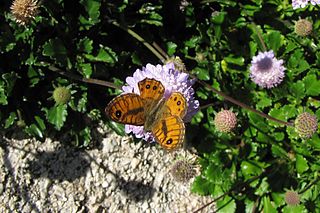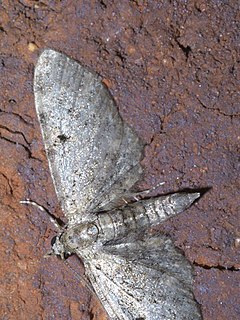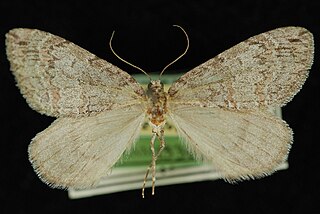
Colias erate, the eastern pale clouded yellow, is a butterfly in the family Pieridae. It is found from south-eastern Europe, through Turkey over central Asia up to Japan and Taiwan. To the south, its range stretches to Somalia and Ethiopia. The species was first described by Eugenius Johann Christoph Esper in 1805.
Holochroa is a monotypic moth genus in the family Geometridae. Its only species, Holochroa dissociarius, is found in North America. The species was described by George Duryea Hulst in 1887 and he described the genus nine years later in 1896.

Plataea is a genus of geometrid moths in the family Geometridae. There are about 11 described species in Plataea.

Lasiommata paramegaera, the pale wall brown or Corsican wall brown, is a butterfly species belonging to the family Nymphalidae. It is endemic to Corsica and Sardinia. The wingspan is 36–40 mm. The upper and undersides of the fore and hind wings are orange brown, they have a dark brown grid-like pattern. The females are often a little lighter colored. Near the apex of the forewing sits a white centred black eye-spot. Between this eye-spot and the outermost apical tip of the fore-wing is another very small black round spot. In the disc region of the top of the forewing, the male has a distinct scent-mark. The upperside of the hind wings has cells 1c, 2, 3, and 4 of the postdiscal region with small black, white-pupilled eye spots on. The underside of the forewings is orange-brown, the underside of the hind wings light brown. On the front wing, the underside pattern corresponds to the upperside. However, the eye spot in the apex is also surrounded by a brown ring.

Iridopsis ephyraria, the pale-winged gray, is a moth of the family Geometridae. The species was first described by Francis Walker in 1860. It is found in the United States and southern Canada east of the Rocky Mountains, from New Brunswick to Florida, west to Texas and north to Alberta.

Costaconvexa centrostrigaria, the traveller or bent-line carpet, is a moth in the family Geometridae. It is native to most of North America, except the Arctic. It is an introduced species in Great Britain, the Canary Islands, the Azores and Madeira.
Eupithecia hohokamae is a moth in the family Geometridae first described by Frederick H. Rindge in 1963. It is found in the United States in southern Arizona and California.

Gadira petraula is a species of moth in the family Crambidae. This species is endemic to New Zealand. It is classified as "At Risk, Naturally Uncommon" by the Department of Conservation. The 2010 and 2011 Christchurch earthquakes destroyed much of the habitat of this species.
Glena quinquelinearia, the five-lined gray, is a species of geometrid moth in the family Geometridae. It was described by Alpheus Spring Packard in 1874 and is found in North America.
Tornos benjamini is a species of geometrid moth in the family Geometridae. It is found in Central America and North America.
Glena interpunctata is a species of moth in the family Geometridae first described by William Barnes and James Halliday McDunnough in 1917. It is found in North America.

Tornos is a genus of geometrid moths in the family Geometridae erected by Morrison in 1875. There are about 17 described species in Tornos.

Hydriomena expurgata is a species of moth in the family Geometridae first described by William Barnes and James Halliday McDunnough in 1918. It is found in North America.
Tornos cinctarius is a species of geometrid moth in the family Geometridae. It is found in North America.
Macronoctua onusta, the iris borer, is a species of cutworm or dart moth in the family Noctuidae. It is found in North America.
Tornos abjectarius is a species of geometrid moth in the family Geometridae. It is found in North America.

Glena nigricaria is a species of moth in the family Geometridae first described by William Barnes and James Halliday McDunnough in 1913. It is found in Central and North America.
Tornos erectarius is a species of geometrid moth in the family Geometridae. It is found in Central America and North America.

Aethalura intertexta, the four-barred gray or smoky carpet moth, is a moth in the family Geometridae. The species was first described by Francis Walker in 1860. It is found in North America.

Helastia clandestina is a moth of the family Geometridae. This species is endemic to New Zealand. It is classified as "At Risk, Relict'" by the Department of Conservation.













